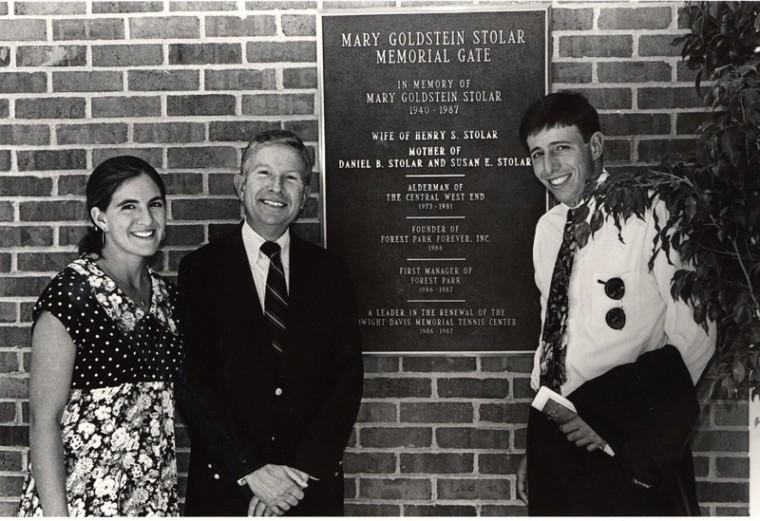Nathan Frank and Forest Park Forever
Published February 23, 2012
Forest Park was aptly described as “The Jewel of St. Louis” by co-authors Sally J. Altman and Richard H. Weiss in their coffee table book of that title a few years back.
Lest St. Louisans take for granted the beautiful public park, which draws 12 million visitors per year and is larger than the world-famous Central Park in New York City, consider for a moment how bleak our metropolitan community would be without the beautiful green space in the midst of a compact urban center. In addition to offering numerous recreational opportunities, it , contains such amenities as the St. Louis Zoo, the St. Louis Art Museum, the St. Louis History Museum and of course, the Muny.
Readers of the Jewish Light may not be aware of the extent to which members of the local Jewish community have played a continuous role in Forest Park’s development through the years, from the 1904 World’s Fair through the very successful Forest Park Forever project.
One of the earliest generous supporters of Forest Park was Nathan Frank, a towering figure in both the Jewish and general communities of St. Louis. Local historian Burton Boxerman, who has written extensively about Frank, points out that he lived in St. Louis from 1867 until his death in 1931 at the age of 79. “He was extremely active in civic and political affairs,” writes Boxerman, “and in 1888 became the first and only Jew to represent Missouri in the U.S. Congress, where he served a single term.” Boxerman adds that Frank made three unsuccessful attempts to win the Republican Party’s nomination for U.S. Senator from the Show-Me State.
Frank played a huge role in bringing the Louisiana Purchase Exposition (World’s Fair) to St. Louis in 1904, and served on its executive committee. Like his fellow Jewish St. Louisan Joseph Pulitzer, who founded the St. Louis Post-Dispatch, Frank founded the St. Louis Star, which later became the St. Louis Star-Times, competing head-to-head with the P-D and the old St. Louis Globe-Democrat when St. Louis was a three-newspaper town. He was also an active member of Congregation Shaare Emeth, which named a chapel in his honor, and he supported the Jewish Orphans Home and the Jewish Federation of St. Louis, among many other charities and causes.
Frank donated funds in 1925 for the construction of an ornate bandstand located in the center of the lagoon across from the Muny. After Frank’s death in 1931, it was renamed the Nathan Frank Bandstand. Over the years, the bandstand fell into disrepair. A fundraising drive was launched in 1980 by the Central West End Charitable Trust and $33,000 was raised, making possible repairs to the roof and the electrical system, but much more work remained to be done.
Fortunately, another member of the Jewish community, the late Mary Goldstein Stolar, came to the rescue by becoming the driving initial force behind the Forest Park Forever project. Stolar was named to head up the effort by Nancy Rice, then director of St. Louis Parks.
Stolar was remarkably successful in raising not only enough funds to restore the Nathan Frank Bandstand to its former splendor, but to re-landscape all of Forest Park, replacing and repaving crumbling streets and sidewalks and polishing the jewel of St. Louis to sparkling perfection.
Helping Mary Stolar in this effort was the late civic leader Howard Baer, who had been responsible, with the late Rabbi Ferdinand Isserman for the Jewish Tercentenary Monument and Fountain across from the Chase-Park Plaza Hotel.
Mary Stolar, who had also served as a member of the St. Louis Board of Alderman, lost a long and brave battle with cancer in 1987. In 1991 her memory and contributions to Forest Park Forever were honored with the dedication of the Mary Goldstein Stolar Memorial Gate outside the Dwight Davis Tennis Center in Forest Park.
At the ceremony, which was attended by civic leaders and family members and friends of Mary Stolar, then U.S. Rep. Richard A. Gephardt said, “She (Mary Stolar) was often controversial when it was not easy to be controversial. Very few of us are both great and good, and I believe that Mary Stolar was both great and good.”
Added the late Rabbi Jerome W. Grollman of United Hebrew Congregation, of which Mary Stolar was a member, “Nature is real and there was nothing artificial about Mary,” noting that the gate was a fitting memorial to her legacy.
So, please do not take for granted Forest Park, the “Jewel of St. Louis,” whose development and growth has been generously supported by such exemplary leaders as Nathan Frank, Mary G. Stolar and Howard Baer.
















